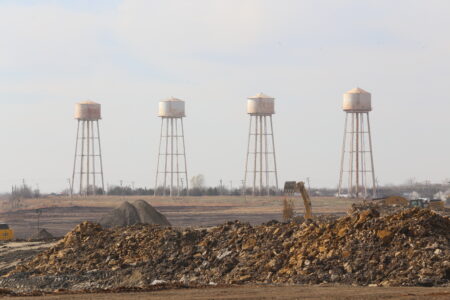Douglas County commissioner voices concerns regarding market adjustments, raises for employees

photo by: Josie Heimsoth/Journal-World
Douglas County commissioners convened before deliberations on the 2026 budget next week on Friday, July 11, 2025.
County commissioners convened for a final meeting on Friday ahead of next week’s budget deliberations. The discussions began with budget lines included in the 2026 proposed budget for market adjustments to align salaries more closely with competing agencies and pay increases for the county’s employees.
Commissioner Gene Dorsey voiced concern about the magnitude of the proposed increases, where $1.4 million is designated for market adjustments and $1.2 million for merit-based raises.
Dorsey said while the proposed budget includes a flat property tax rate, property taxes are still anticipated to increase. He added that he has concerns for older residents on Social Security being unhoused because of the increase in taxes, leading to a larger homeless population in the county.
However, other commissioners said that if the county didn’t stay competitive regarding pay and raises, it will just have to play catch-up in later years.
“I think we’re all trying to find the balance point between the tax burden on our community members and also providing the services and quality of services that we expect,” Commissioner Patrick Kelly said. ” … (But) if we were to reduce our adjustment to pay plan, we’re now getting behind year after year.”
As the Journal-World reported, last year, county commissioners allocated $3 million to implement the findings from human resources group McGrath – which included recommendations to raise county employees’ pay to align them well above area averages. However, despite those adjustments, concerns remain about retaining talent.
“And even with the (salary adjustments) made last year, we’re not at that level, and it’s very easy to leave one government and go to another that’s stationed in the same city,” Commissioner Karen Willey said. “I think we make up for it by being a fun and rewarding place to work, and I think we have fantastic and phenomenal staff, and I don’t want to incentivize them to leave.”
County Administrator Sarah Plinsky said staff recommended the McGrath study after department heads reported hiring difficulties. She warned that failing to keep up with the market now could lead to higher costs in the next adjustment.
Dorsey also suggested capping salary increases for elected county officials, including commissioners, because he sees the role as a public service to the community. Dorsey added that while the job of commissioner takes a lot of time, it doesn’t need a significant pay increase year after year. As a part of the proposal, Plinsky said that the County Commission as a whole would receive an additional $16,000 in 2026.
Willey said that while serving as a commissioner is a public service, commissioners shouldn’t be devalued and separated from the rest of the organization. And Commissioner Shannon Reid said she didn’t want to go further down this “rabbit hole” in exploring cutting the funding for commissioners since the funding was included in the proposed budget.
Plinsky suggested exploring county commissioner pay in the area further and to discuss the topic more in the fall.
Talks on even more funding to Fire Medical
Lawrence-Douglas County Fire Medical has met with the County Commission multiple times ahead of budget hearings to request additional funding after the City of Lawrence, in April, directed the department to find ways to reduce its city funding by between $1.5 million and $1.9 million.
The County Commission has expressed support for allocating more dollars to sustain EMS services in the department, and at the hearings this week, commissioners discussed taking it a step further and purchasing an additional 40-hour ambulance on top of what was included in the proposed 2026 budget.
On Friday, commissioners introduced a new option to convert the 40-hour-per-week ambulance into a 24-hour daily service. However, maintaining all the services already included in the proposed budget — along with the addition of either the 40-hour or 24-hour ambulance — would significantly raise the overall allocation to LDCFM compared to the original proposal.
The decision will come down to whether commissioners want to also give LDCFM a 40-hours-per week ambulance in addition to what was proposed, costing $528,589, or a 24-hour ambulance, totaling over $1.1 million. Kelly told commissioners that based on the conversations on Friday, the commission may need to have a mill levy — or property tax rate – increase, but it all depends on the other budget choices that need to be made.
Reid said she’s more interested in the funding option that includes the 24-hour ambulance because there is a lot of data collected over the years suggesting that another ambulance has been needed for some time, and it will help the county prepare for the new fire station, known as “Station 6.”
The city’s Capital Improvement Plan lists $1.5 million for the construction of the new station in 2026, then $5.4 million in 2027 and $5.7 million in 2028.
“Operating dollars haven’t been explicitly talked about there yet, but we can lead by example in some ways,” Reid said. “And also, I think that financially, we can absorb it easier now and could potentially avoid any mill levy increase in the future, and that part of it interests me very much.”
Commissioner Erica Anderson said she also felt strongly about the 24-hour ambulance option.
“I think we have a lot of work to do in working with the city and coming together and collaborating,” Anderson said. “But at the same time, when we think about the physical and mental well-being, whether it be for our residents and for the membership that’s actually serving our residents, I think we have to ensure that we’re actually showing up for them and building a system that actually supports the population that we serve.”
The proposed 2026 budget from county staff would increase the funding toward LDCFM by $183,758. This increase will keep many of LDCFM’s current resource levels steady, including 24-hour ambulances, six battalion chief positions and a training lieutenant.
If the county did nothing, the number of full-time Fire Medical positions that would be cut would be 18. However, with the proposed funding increase from the county, only 10 positions would be cut. Due to existing vacancies on staff, no existing LDCFM employees would be laid off, officials have said.
Behavioral health sales tax
The county’s quarter-cent mental health sales tax – which was approved by voters in 2018 – funds behavioral health projects and services to improve mental health and addiction support in the community. In the past, it was used to fund large infrastructure projects, such as the construction of the Treatment & Recovery Center of Douglas County.
However, county staff prepared a list of additional funding requests from county departments and community partners that would be eligible for using funds from the tax – and it totals 21 requests. The list of requests included both one-time and ongoing amounts that were eligible for the fund.
The fund has a capacity of approximately $11 million to support behavioral health projects every year, and currently, around $9.4 million is being allocated to ongoing projects. Plinsky informed commissioners that about $1.6 million is available in this budget cycle for new ongoing projects, Meanwhile, the requests for 2026 total over $2.9 million, meaning that not all ongoing requests for 2026 will be able to be funded.
Willey said it can get tricky when organizations come to the County Commission asking for one-time dollars to fill a funding gap in operations, but then it ends up recurring in the next year.
Reid said there were no service contracts for the one-time funding requests to support funding gaps in previous years from Bert Nash Community Mental Health Center and HeadQuarters Kansas, and she doesn’t believe there is any obligation for the county to allocate funds toward them.
What’s next?
County staff are proposing a $191.4 million budget for 2026 that holds the property tax rate flat at 41.298 mills. A homeowner with a $600,000 property would pay $2,850 in property taxes to the county under the proposed rate. A $300,000 home would have a bill of $1,425, and a $200,000 home would incur $950 in taxes.
The tax a property owner pays is determined by both the mill levy and the property’s assessed value, so even if tax rates stay steady or are lowered, rising property values might still cause tax bills to go up for many residents. The total assessed property valuation in Douglas County increased 5.7% in 2025, compared to 6.8% in the previous year.
Budget deliberations for the 2026 budget will take place on Monday and Tuesday from 9 a.m. to noon. If needed, Wednesday is set aside for an additional day of deliberations.
The public is invited to attend in person or virtually on Zoom. No public comment will be taken during the deliberations. The details from the meeting and recordings will be available on the county website.
Additional hearings are also scheduled for the five-year Capital Improvement Plan and Douglas County Consolidated Fire District No. 1, which is scheduled to take place at 4 p.m. on Wednesday, Aug. 6.
The County Commission is currently scheduled to adopt the 2026 budget during a public hearing at its business meeting on Wednesday, Aug. 27. Residents can read the full proposed budget for 2026 on the Douglas County’s Budget and Finance webpage.







